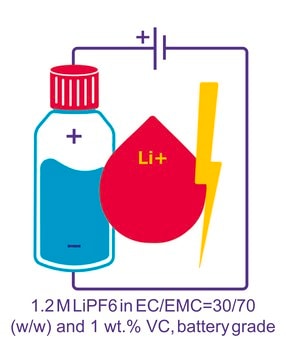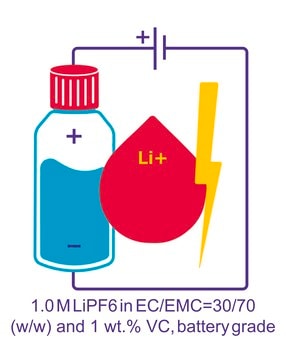934836
Lithium hexafluorophosphate solution
in ethylene carbonate and dimethyl carbonate with vinylene carbonate additive, 1.2 M LiPF6 in EC/DMC=30/70 (w/w) + 1 wt.% VC, battery grade, ≥99.95% trace metals basis
Synonim(y):
1.2 M LiPF6 in EC/DMC=30/70 (w/w) + 1 wt.% VC
About This Item
Polecane produkty
klasa czystości
battery grade
Poziom jakości
Próba
≥99.95% trace metals basis
Postać
liquid
charakterystyka ekologicznej alternatywy
Design for Energy Efficiency
Learn more about the Principles of Green Chemistry.
sustainability
Greener Alternative Product
stężenie
(LiPF6 1.2 M)
zanieczyszczenia
≤100.0 ppm H2O
≤250.0 ppm KF
kolor
clear colorless to faint yellow
gęstość
1.24733 g/mL
Zastosowanie
battery manufacturing
kategoria ekologicznej alternatywy
ciąg SMILES
F[P-](F)(F)(F)(F)F.[Li+]
InChI
1S/F6P.Li/c1-7(2,3,4,5)6;/q-1;+1
Klucz InChI
AXPLOJNSKRXQPA-UHFFFAOYSA-N
Szukasz podobnych produktów? Odwiedź Przewodnik dotyczący porównywania produktów
Opis ogólny
Zastosowanie
Hasło ostrzegawcze
Danger
Zwroty wskazujące rodzaj zagrożenia
Zwroty wskazujące środki ostrożności
Klasyfikacja zagrożeń
Acute Tox. 4 Oral - Eye Dam. 1 - Flam. Liq. 2 - Skin Corr. 1A - Skin Sens. 1 - STOT RE 1 Inhalation - STOT RE 2 Oral
Organy docelowe
Bone,Teeth, Kidney
Kod klasy składowania
3 - Flammable liquids
Klasa zagrożenia wodnego (WGK)
WGK 2
Temperatura zapłonu (°F)
69.8 °F
Temperatura zapłonu (°C)
21 °C
Certyfikaty analizy (CoA)
Poszukaj Certyfikaty analizy (CoA), wpisując numer partii/serii produktów. Numery serii i partii można znaleźć na etykiecie produktu po słowach „seria” lub „partia”.
Masz już ten produkt?
Dokumenty związane z niedawno zakupionymi produktami zostały zamieszczone w Bibliotece dokumentów.
Nasz zespół naukowców ma doświadczenie we wszystkich obszarach badań, w tym w naukach przyrodniczych, materiałoznawstwie, syntezie chemicznej, chromatografii, analityce i wielu innych dziedzinach.
Skontaktuj się z zespołem ds. pomocy technicznej












